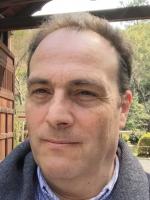
Career
- 2018-date: Royal Society E.P. Abraham Professor, DAMPT, Cambridge
- 2011-date: Herchel Smith Chair in Physics, Cavendish Laboratory,
- Cambridge
- 2002-2010: Personal Chair in the Theory of Condensed Matter, Cavendish Laboratory,
- Cambridge
- 2000-2002: University Readership in the Theory of Condensed Matter, Cavendish Laboratory, Cambridge
- 1995-1999: Lecturer, Cavendish Laboratory, Cambridge
- 1995-date: Fellow, St John’s College, Cambridge
- 1994-1995: Royal Society Research Fellow and Lecturer, Imperial College, London
- 1990-1991: Junior Research Fellow, Gonville and Caius College, Cambridge
Research
Ben is a member the Department of Applied Mathematics and Theoretical Physics and the Cavendish Laboratory, Department of Physics. He also holds affiliated positions in the Wellcome Trust/CRUK Gurdon Institute and the Wellcome Trust/MRC Stem Cell Institute. His research interests have spanned a wide range of topics within the area of theoretical quantum condensed matter physics. However, his current interests are focussed on the application of modelling approaches to study the dynamics of biological systems, from subcellular processes, to cell fate decision-making and morphogenic processes. His research is supported by grants from EPSRC, the Wellcome Trust, CRUK and the Royal Society.
Selected Publications
- S. Rulands, et al., Universality of clone dynamics during tissue development, Nature Physics 14, 469-474 (2018)
- E. Hannezo, et al., A unifying theory of branching morphogenesis, Cell 171, 242-255 (2017)
- X. Lan, et al., Cell fate mapping of human glioblastoma reveals an invariant stem cell hierarchy pre- and post-treatment, Nature 549, 227-232 (2017)
- A. Sanchez-Danes, et al., Defining the clonal dynamics leading to tumor initiation, Nature 536, 298-303 (2016)
- B. D. Simons and H. Clevers, Strategies of stem cell self-renewal in adult tissues, Cell 145, 851-862 (2011)
- C. Lopez-Garcia, et al., Intestinal stem cell replacement follows a pattern of neutral drift, Science 330, 822-825 (2010)
Publications
Remediating Phonological Deficits in Dyslexia with Brain-Computer Interfaces
(2024)
13
(doi: 10.1007/978-3-031-49457-4_2)
Heterogeneous murine peribiliary glands orchestrate compartmentalized epithelial renewal
– Developmental Cell
(2023)
58,
S1534-5807(23)00522-1
(doi: 10.1016/j.devcel.2023.10.004)
Wound-healing plasticity enables clonal expansion of founder progenitor cells in colitis
– Developmental Cell
(2023)
58,
2309
(doi: 10.1016/j.devcel.2023.08.011)
Different niches for stem cells carrying the same oncogenic driver affect pathogenesis and therapy response in myeloproliferative neoplasms
– Nature Cancer
(2023)
4,
1193
(doi: 10.1038/s43018-023-00607-x)
A computational pipeline for spatial mechano-transcriptomics
(2023)
(doi: 10.1101/2023.08.03.551894)
Cancers make their own luck: theories of cancer origins
– Nature reviews. Cancer
(2023)
23,
710
(doi: 10.1038/s41568-023-00602-5)
Inflationary theory of branching morphogenesis in the mouse salivary gland
– Nat Commun
(2023)
14,
3422
(doi: 10.1038/s41467-023-39124-x)
Chronic in vivo imaging defines age-dependent alterations of neurogenesis in the mouse hippocampus.
– Nat Aging
(2023)
3,
380
(doi: 10.1038/s43587-023-00370-9)
Red2Flpe-SCON: A Versatile, Multicolor Strategy for Generating Mosaic Conditional Knockout Mice
(2023)
(doi: 10.1101/2023.02.09.527641)
A cellular hierarchy of Notch and Kras signaling controls cell fate specification in the developing mouse salivary gland.
– Developmental Cell
(2023)
58,
94
(doi: 10.1016/j.devcel.2022.12.009)
- <
- 3 of 30
